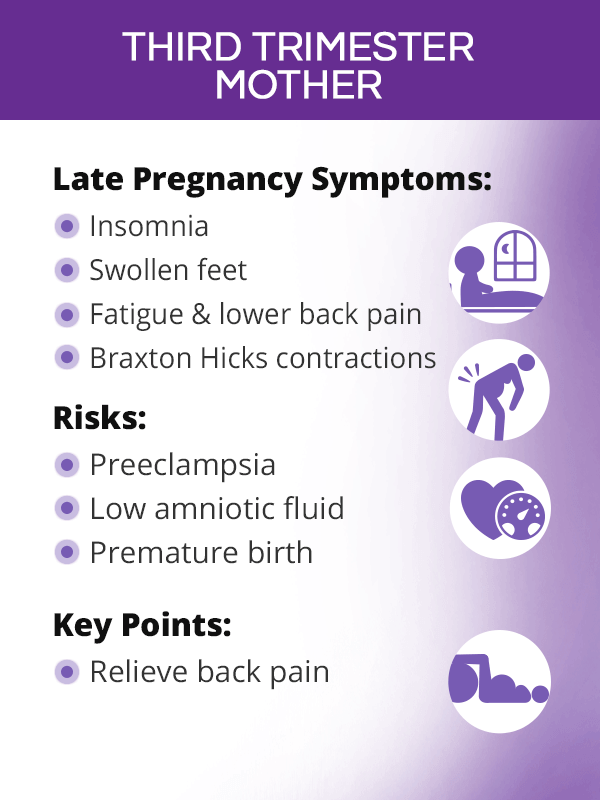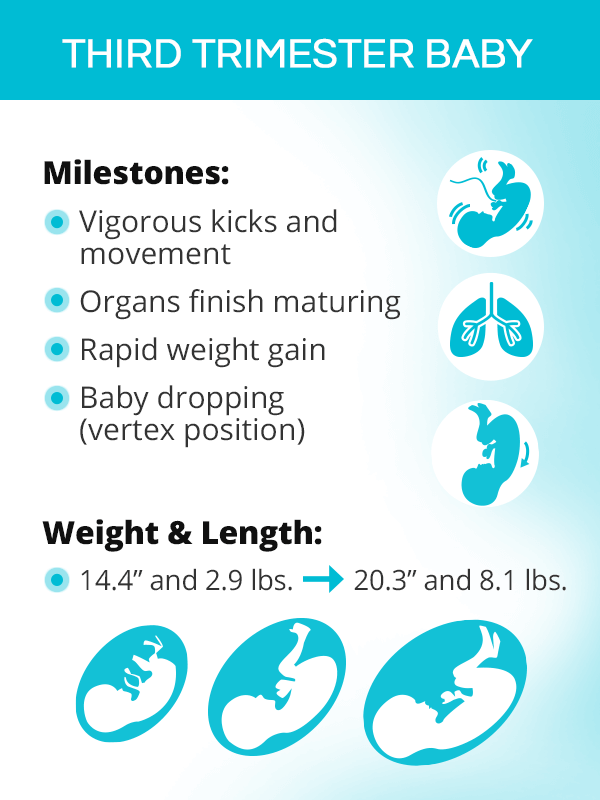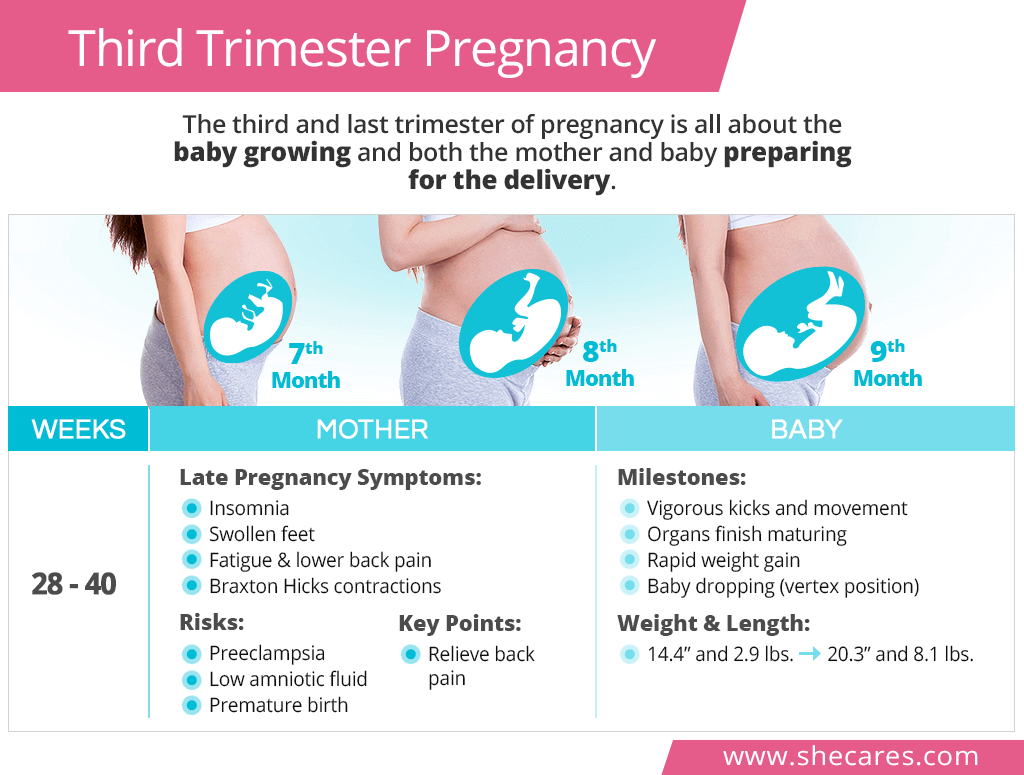Third Trimester Weeks

The third and last pregnancy stage is counted the time from the 28th to the 40th week, or until birth.
According to official guidelines, a “full time” pregnancy lasts between 39 weeks and 0 days to 40 weeks and 6 days.1
However, it is normal for women to deliver their babies between the 37th and 42nd week of pregnancy.2 Premature birth is one that takes place before the 37th week.3
Third Trimester Mother

The lessening of discomforts and increased energy that came with the second trimester are often over as women enter their third trimester.
A rapidly growing baby puts extra weight on their bodies, giving rise to new pregnancy symptoms, from swollen feet and back pain to mood swings and extreme fatigue. Shortness of breath, insomnia, heartburn, and frequent urination are also common as an expanding uterus puts pressure on other organs. It is also common for women to experience practice contractions, called Braxton Hicks contractions, which is how the uterine muscles rehearse before birth.
The third trimester is also the time when potential pregnancy complications can arise, including preeclampsia, low amniotic fluid, or preterm birth. Consequently, mothers-to-be as well as their babies will be closely monitored in the last pregnancy stage.
Third Trimester Baby

The life of a third trimester baby is all about gaining weight, growing from 14.4 inches and 2.9 pounds to 20.3 inches and an astounding 8.1 pounds. In the seventh month, the baby is moving and kicking, which a woman is encouraged to count kicks as a means of monitoring fetal development. But as the baby grows and fills up more space in the uterus, the movements will not be as vigorous.
Most of his or her organs are already developed and functioning in the third trimester, except for the lungs that mature in the last few weeks of pregnancy. The baby also begins to resemble him or herself at the time of birth with fully developed facial features, like eyebrows or eyelashes, as well as fingernails.
A few weeks before delivery, the baby will descend into the pelvic area with the heading facing the birth canal in preparation for delivery, which is commonly called baby dropping. If this does not occur, and the baby is in breech position with his or her buttocks or legs down, a doctor will evaluate the best ways to deliver the baby safely.
Third Trimester Tests
Prenatal testing during the third trimester is focused on making sure that the baby and the mother are healthy and safe until full term. As such, the prenatal visits will be more frequent, taking place every week in the last month of pregnancy.
As a woman approaches her estimated due date, she will be offered a number of tests, including:
Blood and urine tests: to detect the presence of sugar, protein, or bacteria as signs of complications
Group B streptococcus test: a rectal and vaginal swab to detect bacteria that might cause infections in newborns (35-37 weeks)
Ultrasound: although not routine in the third trimester, can be used to monitor the baby's well-being (32-36 weeks)
Moreover, a variety of other non-invasive tests might be ordered to evaluate baby's heart rate as well as respiration, movement, and levels of amniotic fluid, among other parameters. They include electronic fetal heart rate monitoring, non-stress test, or biophysical profile.
Third Trimester Tips
Because of the aforementioned discomforts in the third trimester, a woman's daily activities or travel plans might be partially compromised. Some of the most useful and healthy tips during pregnancy to keep women comfortable might include the following:
Taking frequent breaks and elevating your feet as often as you can
Wearing well-fitted, comfortable shoes
Buying a long pregnancy pillow for back and knee support at night
Maintaining regular, low-level exercise, like swimming, to relieve back pain and take the pressure off joints
Enrolling in prenatal classes to learn about various types of labor and decrease stress during pregnancy
Packing your hospital bag and keeping it handy
Similarly to the second trimester, a woman with a normal preconception weight is encouraged to add 300 calories a day to avoid excess pregnancy weight gain and ensure the baby has all the nutrients she or he needs to grow.4 Women who have had a low or high body mass index (BMI) prior to conceiving will have varying recommendations.
Key Takeaways
Women typically enter the third trimester with the prism of the upcoming childbirth. After enjoying a little break from pregnancy symptoms, they are once again plagued with a number of discomforts as their bodies prepare for the delivery. While they struggle with swollen feet, extreme fatigue, and sleeping problems, their babies are very busy gaining weight and putting the final touches to their development. By the ninth month, all of their organs are mature and working. Various tests throughout third trimester weeks will monitor fetal well-being and ensure that the baby has taken on vertex position with the head facing the birth canal. Meanwhile, women are encouraged to try to maintain themselves comfortable by relieving back pain with gentle exercise, wearing comfortable shoes, and easing their anxiety by preparing for birth. Soon enough, this long, three-trimester journey will bear beautiful and worthwhile fruits.
Sources
- Better Health Channel. (2012). Pregnancy - week by week. Retrieved June 13, 2019 from https://www.betterhealth.vic.gov.au/health/healthyliving/pregnancy-week-by-week
- Cleveland Clinic. (2014). Stages of Pregnancy & Fetal Development. Retrieved June 13, 2019 from https://my.clevelandclinic.org/health/articles/7247-fetal-development-stages-of-growth
- Embryology. (2019). Fetal Development. Retrieved June 13, 2019 from https://embryology.med.unsw.edu.au/embryology/index.php/Fetal_Development
- March of Dimes. (2018). What is Full Term? Retrieved June 13, 2019 from https://www.marchofdimes.org/pregnancy/what-is-full-term.aspx
- National Child & Maternal Health Education Program. (n.d). Full-Term Pregnancy. Retrieved June 13, 2019 from https://www1.nichd.nih.gov/ncmhep/initiatives/know-your-terms/Pages/moms.aspx
- Office on Women's Health. (2019). Stages of Pregnancy. Retrieved June 13, 2019 from https://www.womenshealth.gov/pregnancy/youre-pregnant-now-what/stages-pregnancy
- Planned Parenthood. (n.d.). Pregnancy: Month by Month. Retrieved June 13, 2019 from https://www.plannedparenthood.org/learn/pregnancy/pregnancy-month-by-month
- Sutter Health. (n.d.). Fetal development. Retrieved June 13, 2019 from http://www.babies.sutterhealth.org/babygrowth/fetaldev/index.html
Footnotes:
- KidsHealth. (n.d.). A Week-by-Week Pregnancy Calculator. Retrieved September 9, 2021 from https://kidshealth.org/en/parents/pregnancy-calendar-intro.html
- March of Dimes. (2018). What is full term? Retrieved September 9, 2021 from https://www.marchofdimes.org/pregnancy/what-is-full-term.aspx
- World Health Organization. (2018). Preterm birth. Retrieved September 9, 2021 from https://www.who.int/news-room/fact-sheets/detail/preterm-birth
- American Pregnancy Association. (n.d.). Pregnancy Nutrition. Retrieved September 9, 2021 from
https://americanpregnancy.org/healthy-pregnancy/pregnancy-health-wellness/pregnancy-nutrition/
